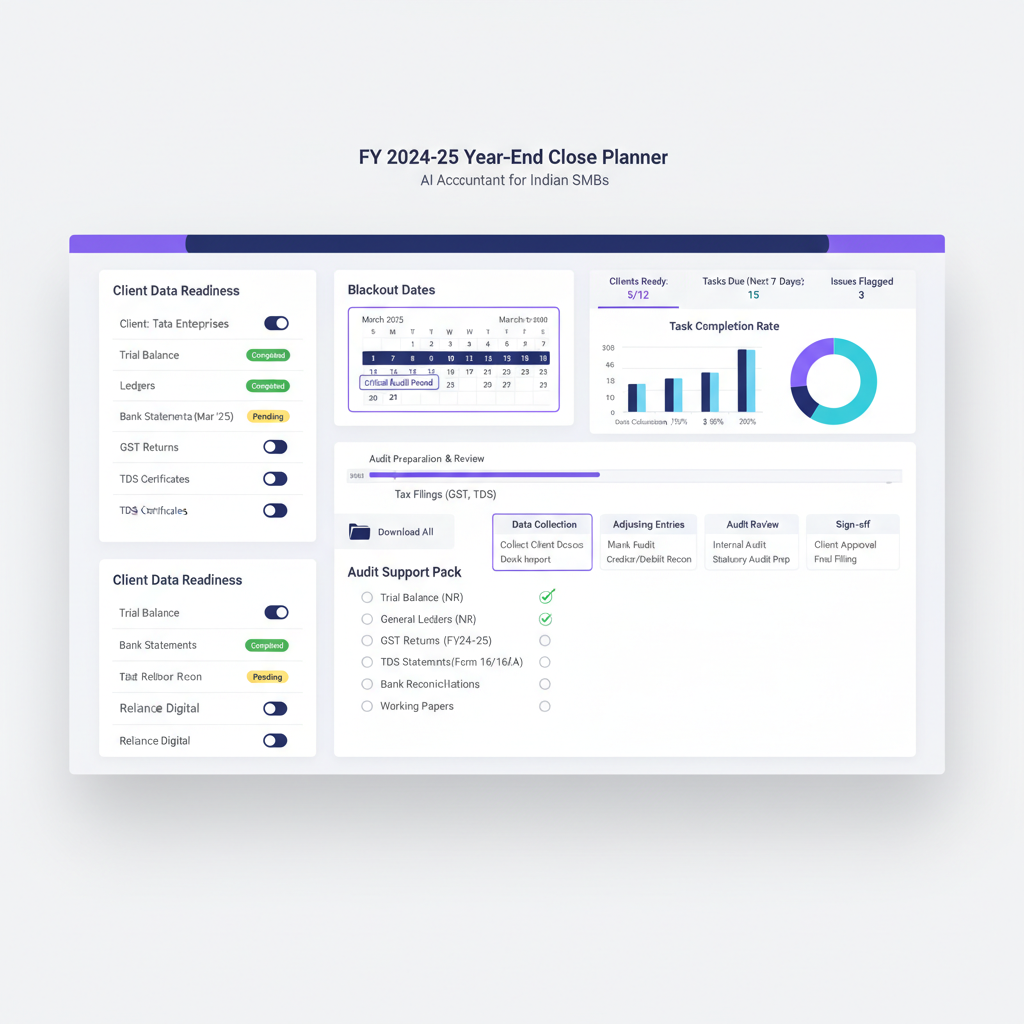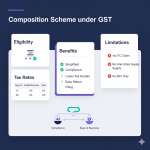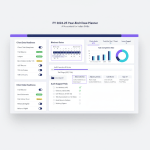Key takeaways
- A robust year end close plan transforms March chaos into a predictable, repeatable process with clear owners, deadlines, blackout periods, and audit-ready documentation.
- Start early with a T-45 to T+15 blueprint, enforce blackout dates, and run a soft close to surface issues before they snowball.
- Staffing, shifts, and a RACI matrix prevent burnout, ensure coverage, and reduce rework through strong review workflows.
- Client data readiness, with disciplined request lists and validation, shifts your team from data entry to analysis.
- Reconciliations, standard journals, and tight controls form the backbone of accuracy, audit speed, and regulatory compliance.
- Use automation where it matters, for example, AI Accountant, to ingest, categorize, reconcile, and sync data cleanly into Tally or Zoho Books.
- Measure every close with KPIs, run retrospectives, and improve one constraint at a time for compounding gains.
Table of contents
What is a Year End Close Plan?
Every March, the same pattern repeats for Indian SMBs and CA firms, GST rushes, bank recs stack up, TDS mismatches crop up, auditors ask for documents at the worst time. A smart year end close plan turns that chaos into clockwork.
At its heart, a year end close plan is an integrated framework, not just a checklist. You get a calendar with clear owners and deadlines, staffing and shifts for peak days, defined blackout dates to prevent last minute system changes, client data readiness criteria, a standard journal checklist, stepwise reconciliations, and a bulletproof audit support pack. Success looks like on time close, zero orphan tasks, minimal rework, and fast audit query resolution.
Your year end close becomes a repeatable process, not an annual emergency.
For a practical overview, see year end made simple, an Indian SMEs guide to audit readiness, a helpful year end financial business checklist, and an year end accounting checklist.
Creating Your Year End Close Timeline Blueprint
Timing is everything. Your timeline blueprint breaks work into phases, from pre close hygiene to audit support.
T-45 to T-15, build momentum
- Clean up ledgers, update master data, send confirmations, check GRNs and IRNs.
- Finalize request lists to clients, communicate blackout dates, lock scope creep.
T-14 to T-1, data completeness
- Run a soft close dry run, complete physical inventory counts, verify fixed assets.
- Document with memos, align provisions logic, queue standard journals.
T0 to T+5, execution window
- Post all journals, complete reconciliations, freeze trial balance, no exceptions.
T+6 to T+15, audit preparation
- Compile audit support pack, conduct management reviews, brief the board if required.
Blackout dates are your guardrails. Freeze policy changes, ERP modifications, and SKU master updates from T-7 to T+5, so reconciliations stay stable when accuracy matters most.
Learn more from this audit readiness explainer and a concise financial year end checklist.
Managing Staffing and Shifts During Close
Your team can make or break the close. Capacity plan by functional lanes, AP and AR, GST and TDS, fixed assets, revenue, inventory, intercompany. Assign primary owners with backups and pair preparers with reviewers.
- Design shifts for coverage, early shifts gather and process, late shifts review and escalate, weekends and holidays are pre planned.
- Use a RACI for every task, clarify responsible, accountable, consulted, informed.
- Protect people, cap hours, enforce handoffs, run short daily standups to clear blockers fast.
Remember, a tired accountant makes avoidable mistakes, and rework during close is a silent delay multiplier.
Practical guidance, see this year end planning guide and this close checklist.
Ensuring Client Data Readiness
Define “ready to post.” Files complete, naming conventions followed, formats accepted, approvals documented. Issue comprehensive request lists early, bank statements, GST returns and reconciliations, TDS certificates and Form 26AS, payroll registers, inventory count sheets, balance confirmations.
Validate upon receipt, OCR readability, deduplicate, version control, and daily status on a shared dashboard. For setup ideas, explore a digital client portal.
Modern automation changes the game. Tools like AI Accountant bulk ingest documents, structure statements, match transactions, and flag gaps early, so your team focuses on analysis, not typing.
Context and checklists, see this audit readiness guide for Indian SMEs.
Mastering Reconciliations and Tie Outs
Reconciliations verify that books reflect reality.
- Bank, cover every account, chase items older than 30, 60, 90 days, document provisions for stale items.
- AP and AR, use aging, focus on top counterparties and related parties, confirm balances, document disputes or payment plans.
- GST, match GSTR-2B reconciliation to purchase book, identify ITC reversals and ineligible credits, reconcile TDS payable with Form 26AS.
- Loans and FX, match interest to statements, revalue monetary items, document exchange rate sources.
- Inventory, tie physical counts to system, mark WIP, compute obsolescence and write downs for damaged goods.
- Fixed assets, confirm capitalization cutoffs, remove disposals, true up depreciation, review for impairment triggers.
Each reconciliation needs proof, screenshots, calculations, variance explanations, and approved adjustments. For additional best practices, check a financial year end checklist, an outsourcing hub close checklist, a quick financial year end explainer, a tax checklist before 31 March, and closure guidelines for Indian entities.
Building Your Standard Journal Checklist
A strong journal checklist prevents last minute surprises.
- Accruals, utilities unbilled, audit fees, bonus provisions, straight line rent adjustments.
- Provisions, ECL for doubtful debts, warranty obligations, stock obsolescence, asset impairment.
- Prepaids and deferrals, insurance, AMCs, advance rentals, unearned revenue for incomplete services.
- FX revaluation, unrealized gains and losses on monetary assets and liabilities, use RBI reference rates consistently.
- GST adjustments, Rule 42 and 43 reversals, clear GSTR-2B mismatches, annual reconciliations and true ups.
- TDS provisions, compute by category, gross up if contracts require, verify with Form 26AS.
- Intercompany eliminations, remove intra group sales and purchases, TP adjustments, eliminate unrealized profit in inventory.
- Payroll accruals, leave encashment, gratuity, bonuses per agreements.
- Financial instruments, interest accruals, EIR amortization, fair value changes where applicable.
Use a standard template, date, description, policy reference, linked workings, and reviewer signoff with timestamp.
Implementing Controls Reviews and Documentation
Controls reduce errors and audit friction. Create workstream checklists with owners and due dates, set materiality thresholds to focus reviews, define evidence standards by area, bank statements for cash, confirmations for receivables, count sheets for inventory, board minutes for provisions.
Run three way sign offs, preparer, reviewer, approver, and track all signoffs with timestamps. Organize documentation so auditors can follow the narrative with minimal queries.
Creating Your Audit Support Pack
A great audit support pack shortens audits dramatically. Build an index, trial balance, GL details, lead schedules, bank recs, confirmations, payroll summaries, GST and TDS reconciliations, loan statements, board minutes, key contracts, and memos. Use a standard folder tree, consistent file names, and map everything to your PBC tracker.
Protect data, restrict access, watermark sensitive files, and align with ISO 27001 or SOC 2 where tools are involved. Define query SLAs, manage versions, and maintain a query log. See this audit readiness guide for India for structure ideas.
Meeting India Specific Compliance Requirements
- Schedule III presentation, correct classification between current and non current, proper disclosures.
- MSME disclosures, track delays, interest obligations, and reporting requirements.
- Related parties, identify all parties, document terms, compare with arm’s length, ensure comprehensive disclosures.
- CSR, compute average net profits, track spends, disclose unspent amounts and set asides.
- CARO, review internal controls, statutory dues, loan utilizations, going concern considerations.
- ICDS, manage tax book differences, deferred taxes, and reconciliations.
- UDIN, ensure generation and verification, maintain records.
- Management representation letters, include Indian regulatory confirmations and get proper signoffs.
Tracking Continuous Improvement Metrics
What gets measured gets better. Track days to close, on time task completion, journal rework, audit query volume and age, reconciliation backlog age. Run retrospectives, find root causes, and implement targeted fixes. Explore ideas from this year end planning checklist.
Look for automation wins, direct bank feeds, AI reconciliations, and predictive alerts on risk areas. Small gains compound, a day saved, an exception prevented, a query avoided.
Selecting the Right Tooling Workflow
Your tooling can accelerate quality and speed.
- AI Accountant, a quiet AI assistant that auto ingests bank statements, categorizes transactions, flags exceptions, and syncs with Tally and Zoho Books, especially strong with Indian bank formats.
- QuickBooks, user friendly, rich integrations, may need localization for GST workflows.
- Xero, clean bank recs and real time collaboration.
- FreshBooks, simple invoicing and expenses for smaller teams.
- Tally Prime, the Indian backbone with native GST and TDS compliance.
Let Tally or Zoho Books be your backbone, layer intelligent automation for ingestion, categorization, reconciliation, and exception reporting. The goal is not replacement, it is leverage, your accountants spend time on analysis and decisions, not repetitive keystrokes.
Essential Templates and Downloads
- Year end close master plan, calendar, RACI, escalations, and success criteria.
- Client data readiness checklist, accepted formats, quality thresholds, deadlines, and escalation triggers.
- Standard journal entry checklist, recurring entries, methods, policy references, PY comparatives.
- Blackout calendar, freeze periods, restricted actions, exception approvers, and communication plan.
- Staffing and shift roster, coverage by function, hours, rotations, and backups.
- Audit support pack tracker, schedule list, prep status, reviewer notes, and auditor queries.
Visualizing Your Close Process
Visuals make complex processes simple. Build a close timeline with milestones and blackout overlays, a RACI snapshot for a typical engagement, a data flow from client upload to audit pack, and dashboards for progress, rec exceptions, and query ageing.
When everyone can see the flow, everyone can improve the flow.
Taking Action on Your Year End Close Plan
Knowledge without action changes nothing.
Start by adopting comprehensive templates, customize for your context, and run a dummy close before year end. Test your monthly close to refine handoffs and comms. If you are ready to accelerate, pilot an automation layer, bulk ingestion, auto categorization, AI reconciliations, and seamless sync into Tally or Zoho Books.
A proper plan replaces panic with process, chaos with control, and late nights with predictable workflows. For additional ideas, explore this Indian SME audit readiness guide.
FAQ
How should a CA structure a T-45 to T+15 close calendar for Indian SMB clients?
Start with T-45 hygiene, ledger cleanup, master data updates, confirmations, GRN and IRN checks. T-14 to T-1, run a soft close, inventory counts, fixed asset verification, documentation. T0 to T+5, post journals and finish reconciliations, freeze the trial balance. T+6 to T+15, prepare the audit support pack and management reviews. Use blackout dates from T-7 to T+5 to protect stability. A tool like AI Accountant can auto ingest and reconcile during T-14 to T+5, reducing manual crunch.
What is a practical RACI model for close tasks that CAs can hand to staff and article assistants?
Assign Responsible to preparers by workstream, AP, AR, GST, TDS, FA, inventory. Accountable should be the team lead or engagement manager. Consulted includes tax and audit reviewers. Informed includes client finance heads. Keep the RACI inside your close tracker, and pair each task with evidence standards. AI Accountant can post status updates and exception flags to your tracker, helping the A and C roles intervene earlier.
How do I enforce blackout dates with clients who keep changing masters in Tally during close?
Communicate freeze dates one month in advance, note what is restricted, policy and master changes, SKU updates, posting backdated entries. Provide an exceptions process with named approvers and a cut off time. If an exception is approved, log the change, re run impacted reconciliations, and capture revised evidence. An AI workflow can detect master changes via periodic extracts, AI Accountant can flag deltas so you immediately assess impact.
What reconciliation evidence do auditors typically accept without pushback?
Bank reconciliations with bank statements, recon sheets, and proof for outstanding items. AP and AR aging with top party confirmations, reconciliation notes for disputes. GST tie outs with GSTR-2B matched to purchase registers and ITC reversal workings, TDS with Form 26AS. Inventory with count sheets and valuation workings. Fixed assets with FA register, capitalization memos, and depreciation workings. Use standard naming conventions and link every recon to your PBC index. AI Accountant can auto attach underlying statements to each recon schedule.
How can I cut journal entry rework during close for multi entity groups?
Standardize JE templates with policy references, computation sheets, and review points. Lock calculation methods for provisions and FX revaluation, and maintain prior year comps for sanity checks. Use maker checker with clear thresholds. For intercompany, run a pre close netting and confirmation loop. AI Accountant can pre compute recurring entries, accruals, FX revals, and intercompany eliminations, so reviewers focus on exceptions instead of inputs.
What KPIs should a CA firm track to prove close efficiency improvements to clients?
Days to close, percentage tasks on time, journal rework rate, audit queries count and average age, reconciliation backlog age, and exception turnaround time. Track per client and per workstream to find constraints. Share a post close dashboard in your management review. AI Accountant provides exception analytics and trend reports you can embed into these dashboards.
How do I align ICDS and Ind AS or AS differences at year end without last minute fire drills?
Maintain a living tax book reconciliation throughout the year, tag transactions that create timing differences, compute deferred tax monthly, and keep a disclosure ready template. Before year end, run a tax technical review for complex areas, revenue recognition, FX, provisions, and financial instruments. With AI Accountant, you can tag transactions, export difference schedules, and keep a rolling deferred tax computation ready for signoff.
What is the most efficient way to manage client document flow for March close?
Issue a comprehensive request list early with formats and naming conventions, bank statements, GST returns, TDS certificates, payroll, inventory counts, confirmations. Validate on intake, OCR readability, duplicates removed, versions tracked. Host a shared portal with status and due dates. A digital portal plus AI Accountant’s bulk ingestion reduces email chaos, standardizes files, and keeps version history clean.
How do I design a close checklist that satisfies Schedule III, MSME, CSR, and related party disclosures?
Add a compliance section to your checklist, map each disclosure to a specific data source and owner, MSME ageing and interest, CSR computation and spends, related party listing, transactions, and balances, Schedule III classification and rounding rules. Include review notes and board minute references. AI Accountant can help extract related party transactions and generate a draft disclosure schedule for review.
How do I get inventory counts right when operations are still shipping during year end?
Use cycle counts ahead of year end, and a controlled cut off window for final counts. Reconcile in transit, goods received not invoiced, and goods issued not recorded. Maintain photographic or system timestamp evidence. Where continuous operations are unavoidable, use test counts with roll forward and roll back procedures. AI Accountant can match count sheets to system stock and flag unusual variances by SKU.
What should be in an audit support pack to minimize day one queries?
Index, trial balance, GL extracts, lead schedules by account with cross references, bank recs for all accounts, confirmations, payroll summaries, GST and TDS reconciliations, loan statements, board minutes, key contracts, policy memos, and JE listing with support. Keep version control and a query log with SLAs. AI Accountant can generate reconciliations, attach primary evidence, and export a clean PBC kit.
How do I coach my team to avoid last mile GST and TDS surprises?
Schedule a T-14 indirect tax review, GSTR-2B to purchase book match, Rule 42 and 43 reversals, vendor follow ups for ITC mismatches, and TDS payable tie to Form 26AS. Lock approvals for disputed items and document positions. AI Accountant’s GST reconciliation module highlights mismatches and pending credits, helping you close gaps before T0.



![All Tally Prime Shortcut Keys For Daily Use [Updated 2026]](https://www.aiaccountant.com/blog/wp-content/uploads/2025/11/Tally_Prime_Shortcut_Keys-150x150.webp?crop=1)
